|
In April, the FWC celebrated Florida Volunteer Month through a social media blitz of service! We shared the accomplishments of our volunteers, interns and the staff and partners who work with them every day in April on our new Facebook page. Through volunteering, you can make a difference for Florida’s fish and wildlife! Please continue to check us out, like and share our page by searching for FWC Volunteers on Facebook!
— FWC Volunteer Team
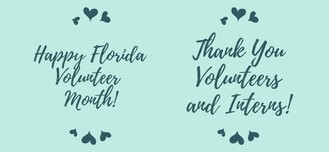
Shorebird Update
By Emily Hardin and Brendan O'Connor
Volunteers, FWC staff and Audubon staff in the Northwest Region show off their finished chick shelters. Photo by Chris Lipps, Audubon Florida.
Shorebird nesting season is in full swing throughout Florida! Chicks have begun to hatch and fledge, and some breeding pairs have laid second clutches. FWC volunteers across the state are helping to monitor shorebirds and educate others about them. We cannot thank our volunteers enough for all their hard work and dedication to helping these species.
Our Bird Steward volunteers are integral to shorebird protection. They visit nesting areas and keep an eye on the birds, eggs and chicks while also educating beachgoers about the birds and the importance of not disturbing them. Stewards are especially vital on busy days such as Memorial Day and Independence Day. Volunteers help the public learn about and view shorebirds from a safe distance and prevent impacts on the birds’ behavior.
FWC volunteers also help monitor and collect data in nesting areas. This involves walking survey routes weekly or monthly to gather information on nesting and hatching activity. It can also mean visiting some shopping centers and hotels! Some species of shorebirds, particularly least terns, have adapted to nesting on gravel rooftops instead of on the busy beaches. Volunteers visit these sites sometimes multiple times a day to collect information on the numbers of birds utilizing the rooftops. With coordination between the FWC and building owners or managers, volunteers also check for any flightless chicks that may have fallen off the edge of the roof and need an extra hand getting back up.
We reported in our Spring 2019 newsletter the effort our volunteers devoted to making chick shelters. As we explained, these shelters serve to provide shade from the sun and a hiding place for chicks to avoid avian predators, such as gulls and crows. Chick shelters are generally made from repurposed materials, making them a low-cost and sustainable tool for protecting shorebird chicks. Chick shelters were built in several locations across the state and deployed before the beach-nesting bird breeding season commenced.
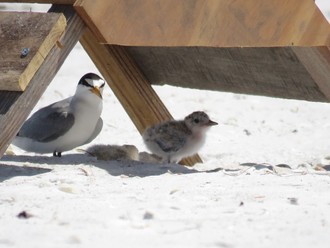 Two least tern chicks and an adult least tern availing of the chick shelters in Lido beach, Sarasota, Florida. Photo by Kylie Wilson, Audubon Florida Anchor Steward.
Seagrass Transplantation Volunteers
By Emily Hardin
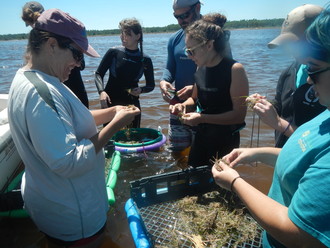 FWC staff and volunteers prepare seagrass to be transplanted to the restoration site. Photo by Katie Konchar.
An ongoing oyster reef restoration project in Bay County has entered an exciting new phase. The project began in 2015 to help mitigate erosion and poor water clarity, and conditions have improved since the project’s beginning. So much so, in fact, that biologists have been able to start transplanting seagrass from other areas of the bay into the restoration site. Volunteers joined FWC and FWRI staff in collecting, preparing, and transplanting the grasses to the site in April, and have been helping to monitor the grasses each month since!
 Photo Left: Seagrass planting units ready to be planted in the restoration site. Photo by Gema Hernán. Photo Right: Newly transplanted seagrasses. Photo by Jacob Berninger.
Apalachicola National Forest Second Annual Wetlands Cleanup
By Emily Hardin
 Volunteers and staff pose before heading off to various wetlands to clean up litter and debris. Photo courtesy of Emily Hardin.
The FWC, US Forest Service, and Coastal Plains Institute joined forces again this year to host a Wetlands Litter Clean-up in Apalachicola National Forest. Volunteers spent a few hours removing over 460 lbs. of garbage from ephemeral wetlands and learning about the species that utilize them!
 Clint Davis and John Dunlap, United States Forest Service staff, unload truckloads of trash collected in the wetlands into a donated dumpster. Photo Courtesy of Emily Hardin.
Marine Fisheries Interns in the Field
By Melissa Crouch
Marine Fisheries Management (DMF) Summer Interns joined FWC staff to observe saltwater artificial reef deployments off Panama City, Florida and conduct a specimen collection at Wakulla Beach, Florida.
 DMF Interns watch as saltwater artificial reefs are deployed off Panama City, Florida. Photo courtesy of Melissa Crouch.
 DMF Interns use a seine net to collect specimens at Wakulla Beach, Florida. Photo courtesy of Melissa Crouch.
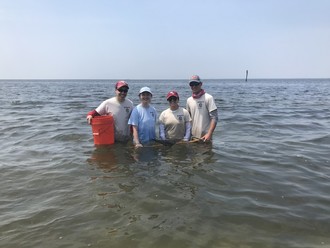 DMF summer interns have a great time during a specimen collection at Wakulla Beach, Florida. Photo courtesy of Melissa Crouch.
Turkey Hazing
By Brendan O'Connor
A senior community in Zephyrhills, Pasco County, reported concerns to the FWC about wild turkeys in their neighborhood showing aggressive behavior when approached by humans. Wild turkeys that lose their natural fear of people can become a public safety concern due to their powerful wings, large size and spurs on the males’ legs. The FWC’s Wildlife Impact Management Section provided advice to resolve the situation. FWC volunteers, Connie Sweet and Larry Wallace, visited the neighborhood to discourage the wild turkeys from foraging in the residential area. They hazed the turkeys by shouting, using an airhorn, opening and closing an umbrella while facing the turkeys, waving their arms and clapping. You can help keep wild turkeys wild by never feeding them. More information on hazing turkeys can be found in our Living with Wild Turkeys brochure.
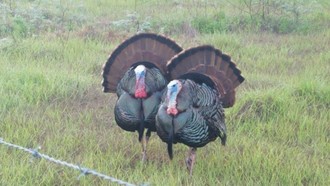 Two tom (male) turkeys. Photo by Larry Wallace, FWC Volunteer.
Support
In addition to your generously donated time and talent, we welcome tax-deductible monetary contributions. Visit the Fish & Wildlife Foundation of Florida to make a donation. Your support will help us expand volunteer opportunities as we work to foster a statewide network of conservation volunteers. Thank you for supporting Florida's fish and wildlife resources!
|